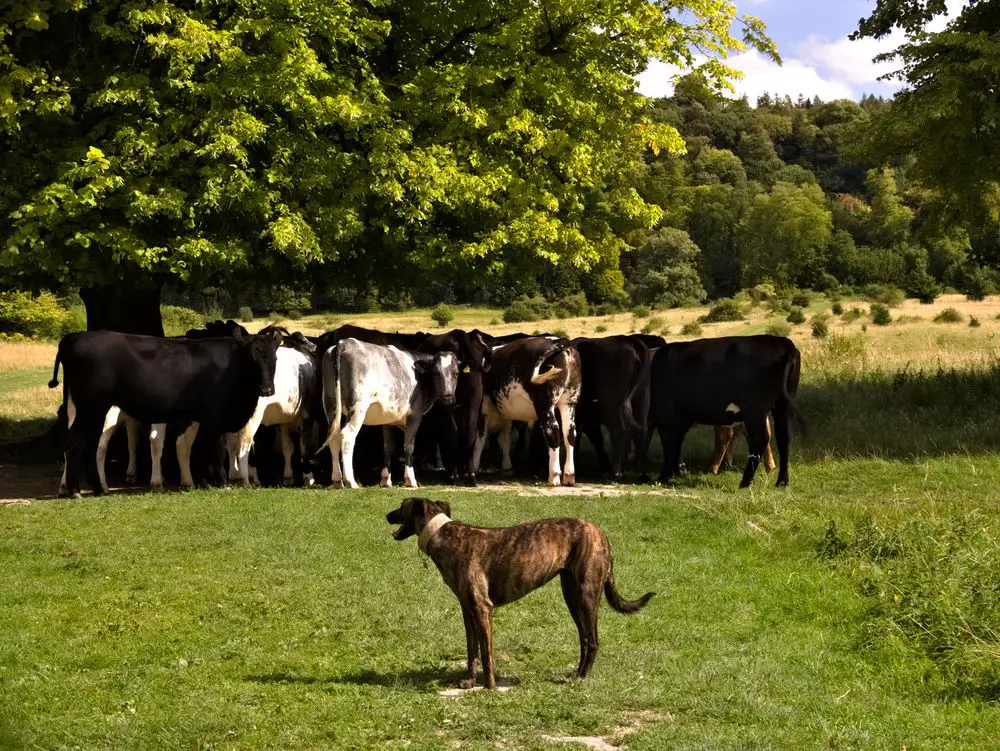Cows huddle together to reduce heat stress and insect bites, to protect the herd and to graze more efficiently. Groups of cows are a common occurrence at most cattle farms and does not highlight any health or territorial concerns within the herd.
Every farmer who raises cattle will notice that cows have a tendency to group together while they are out grazing and while they are in the barn. This behavior might seem random or strange to first-time farmers, but there are a few genuine reasons why cows like to form huddles.
Table of Contents
Common Reasons Cows Huddle Together
As herd animals, cows will instinctively form groups for a variety of reasons. Most of these reasons have the common theme of protection. Their natural instinct drives them to group together in order to protect themselves and their young.
Catle often huddle together:
1. To Reduce Heat Stress
Cows need to stay cool during summer and are affected by heat stress just as we are. Heat stress lowers milk production, makes the cow more vulnerable to disease, and leads to lethargy.
When they are out in the fields grazing, cows will bunch together in shaded areas or areas that have a nice breeze. Dairy cows will also cluster by areas of the barn that have the best airflow in order to cool themselves down, often after following the lead of a senior cow within the herd.
In order to prevent heat stress, most dairy farmers like to keep their barns at cool temperatures, around 65°F. Proper ventilation, sprinkler systems, and cool drinking water are all excellent methods for ensuring that your cows stay cool.
2. To Minimize Insect Bites
Flies and other biting insects are a major nuisance to cows. In particular, stable flies, horn flies, and face flies are the three major species that can be the most invasive in the barnyard.
These flies will swarm a heifer’s back, face, legs and udder. If they aren’t properly dealt with, these parasites can cause serious illnesses in a cow, leading to lower milk production, lameness, and possibly even death.
In order to shoo away these annoying pests, cows like to swish their tails in an attempt to swat the flies. When cows group closely together, it becomes difficult for the flies to land on their bodies.
3. To Ward Off Predator Attacks
There are many common predators of cows, such as coyotes, wild dogs, wolves, cougars, and bears. When facing one of these predators, a cow’s best self-defense mechanism is to band together with the rest of the herd. An individual cow stands little chance against most predators, but a whole herd together has the potential to keep attackers at bay.

They know that their strength is in numbers and will form a tight band around the calves to make sure they are fully protected. Together they will keep their eyes facing the predator to follow their every move, often moving together as one defensive unit when the predator strikes.
4. To Avoid Bright Lights
Cows are surprisingly sensitive to light. It is believed that they instinctively associate the brightness with the sun, and will relate it to being overwhelmingly hot and head towards the barn.
Despite the space, cows will sometimes huddle together while in the barn in order to avoid areas with artificial lights. This isn’t necessarily a bad thing, as your cows aren’t truly going to be overheating if your barn is properly ventilated and kept at an appropriate temperature.
However, if they lack fresh air and are dealing with heat stress, the additional light will only add to their stress levels. Setting your artificial lights barn lights to run on a timer switch can fix this problem.
5. To Graze More Efficiently
Cows will tend to face in the same direction when they are together instinctively for the purposes of grazing and predator protection. While cows are naturally grazing during the day, facing the same direction keeps them from bumping into one another and also allows each of them their own stretch of grass to eat.
If a predator appears, the cows will already be in a proper formation to huddle closer together and all face the predator at once. This defensive wall prevents the predators from attacking the young and weaker cows, while often avoiding confrontation altogether.
FAQs
Why Do They Stand In Circles and Next To Fences?
Cows usually stand in circles for two reasons. One is that they will stand in a circle if they are being fed, all facing inward towards the hay or feed. The second is if they are being attacked by a predator, where they will face outward.
Some predators, such as wolves, like to hunt in packs. If multiple wolves are coming at a herd of cows from different directions, the group of cows will start to form an outward-facing circle with all of the calves being protected at the center.
Cows like to group themselves close to certain sections of fencing mostly when they are trying to avoid the weather. If it is too hot or starting to rain, cows might start to huddle around fences as it is as far as they can go to seek cover while on pasture.
Why Do Cows Huddle Before A Storm?
While the old farmer’s adage that cows can predict a storm might be difficult to prove scientifically, the reasons why cows tend to band together during bad weather are actually quite simple. Cows will huddle together to protect themselves from the wind, and might even tend to lay down.
Most storms bring with them strong and fast winds, which can potentially be dangerous to young calves who could get blown over. To prevent this, the rest of the herd will come together to form a protective barrier from the wind.
